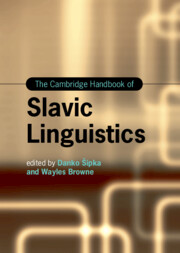Book contents
- The Cambridge Handbook of Slavic Linguistics
- Cambridge Handbooks in Language and Linguistics
- The Cambridge Handbook of Slavic Linguistics
- Copyright page
- Contents
- Figures
- Tables
- Contributors
- Introduction
- Part 1 Prosody and Phonology
- Part 2 Inflectional and Derivational Morphology
- Part 3 Syntax
- 13 Agreement
- 14 Wh-Constructions and Wh-Dependencies
- 15 Coordination and Subordination in Slavic Languages
- 16 Numerals and Quantity Expressions
- 17 Placement and Ordering of the (En)clitics
- 18 Secondary Predication
- 19 Negation and Polarity
- 20 Null Subjects
- 21 Voice
- 22 Morphosyntactic Reflexes of Information Structure
- Part 4 Lexicon
- Part 5 Sociolinguistic and Geographical Approaches
- Part 6 Experimental and Quantitative Approaches
- Name Index
- Subject Index
- References
19 - Negation and Polarity
from Part 3 - Syntax
Published online by Cambridge University Press: 16 May 2024
- The Cambridge Handbook of Slavic Linguistics
- Cambridge Handbooks in Language and Linguistics
- The Cambridge Handbook of Slavic Linguistics
- Copyright page
- Contents
- Figures
- Tables
- Contributors
- Introduction
- Part 1 Prosody and Phonology
- Part 2 Inflectional and Derivational Morphology
- Part 3 Syntax
- 13 Agreement
- 14 Wh-Constructions and Wh-Dependencies
- 15 Coordination and Subordination in Slavic Languages
- 16 Numerals and Quantity Expressions
- 17 Placement and Ordering of the (En)clitics
- 18 Secondary Predication
- 19 Negation and Polarity
- 20 Null Subjects
- 21 Voice
- 22 Morphosyntactic Reflexes of Information Structure
- Part 4 Lexicon
- Part 5 Sociolinguistic and Geographical Approaches
- Part 6 Experimental and Quantitative Approaches
- Name Index
- Subject Index
- References
Summary
This chapter gives an overview of phenomena connected to polarity, especially negation, in Slavic languages. The formation of negation in Slavic is rather uniform across languages and historically relatively stable. Further, the chapter discusses the distribution of linguistic expressions connected to different environments involving polarity. The latter includes negative concord and polarity items with a major focus on different series of indefinites. These environments for indefinites are discussed: (i) specific (known to the speaker), (ii) specific (unknown to the speaker), (iii) non-specific (irrealis), (iv) polar question, (v) conditional protasis, (vi) indirect negations, (vii) direct negation, (viii) standard of comparison, and (ix) free choice. Additional negative polarity items are presented, such as scalar particles. Lastly, the chapter treats case alternations in the scope of sentential negation (genitive of negation), which is a feature inherited from Common Slavic, but not present in all modern Slavic languages. The genitive of negation exhibits differing properties in those languages which preserved it.
- Type
- Chapter
- Information
- The Cambridge Handbook of Slavic Linguistics , pp. 405 - 429Publisher: Cambridge University PressPrint publication year: 2024

